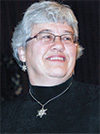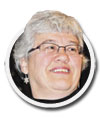Their oldest daughter, Katelyn, and son-in-law, Curtis Delange, are now involved as well.
The farm has seen a number of changes over the years – the most dramatic of which have occurred within the past few months.
Gifford Acres Farm, Ltd., formed in 1986 and named for the township where it is located, will be a featured stop in the popular Dairy Expo Farm Tour, part of the Pacific Agriculture Show to be held in January 2012.
It is expected there will be approximately 800 dairymen and other interested industry people touring the nine selected farms (Click here to read more about the tours).
Farms chosen for the tour are those who are new, have done extensive remodeling or installed new technology to make life easier for the dairyman. Remodeling and technology both figure in at Gifford Acres Farm, as the barn has been set up for one person to operate easily.
Feeding and milking are automated, and the whole setup is organized in a way to streamline labour. There are polyvinyl chloride wall coverings in utility areas, roll-down curtains, TMR feeding, a separate vet room near the robotic milking stations and a heat pasteurizer for calf milk.
Milking
The dairy herd consists of approximately 100 head of purebred Registered Holstein cows, along with youngstock coming along.
The operation raises its own replacements, as well as supplying some for other herds. The barn has been renovated to accommodate the cows in five main groupings – youngstock, dry cows and close-up animals in a group pen, fresh cows in a smaller freestall space and the general milking herd in freestalls.This is a working herd; showing is not part of the family’s plan.
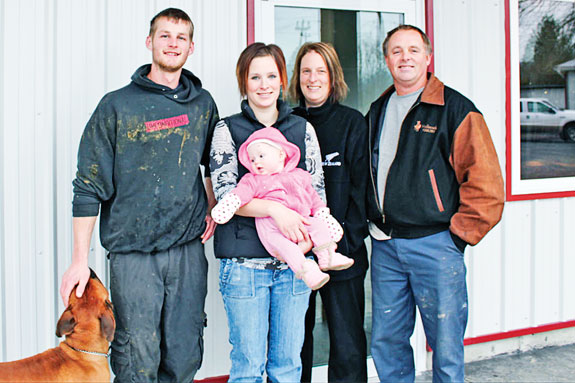
Likely the biggest single change the farm underwent was installing robotic milkers. The two units each have their own room.
Each cow wears a transponder, which gives information concerning her teat placement. An arm swings under the cow, cleaning the udder with soft brushes, and then a laser scans twice to verify where her teats are before attaching the cups.
Each cup has a flow sensor, so that each quarter is milked independently, which improves udder health. The computer flags high somatic counts, picking up cases of mastitis up to 12 hours before clinical signs appear, allowing for earlier treatment and less permanent damage to udders.
Cows choose for themselves how often they want to be milked, as the robot rooms are always open, although a cow that comes in sooner than four hours after her last milking is shunted through.
Cows are flagged as “late” after 12 hours; five to seven cows per day fail to show up on time and the men have to drive them to the robots.
Although they had been advised production would drop a bit while the cows adjusted to the new way of milking, that has not been their experience.
“Didn’t miss a beat ... just went up in production,” Allan states, adding that prior to the robots, they averaged 34 kilograms per day and now are at 39 kilograms per day.
The transponder system detects heat as well, which allows breeding to be timed more accurately. Both men are involved in breeding decisions.
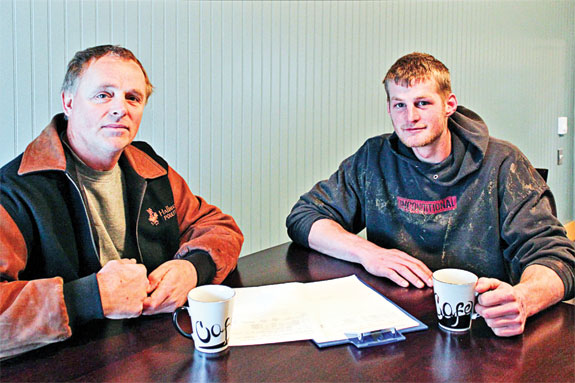
They make use of G-mate, a computer program that makes the best genetic match for each individual cow from within a group of bulls selected by them. Breeding is done by A.I.
Rumination detection, catching cows off feed before clinical signs appear, is also part of the package. Curtis explains that it is like a built-in stethoscope and measures the amount of chewing a cow does. If a health issue is brewing, it can be caught early using this technology.
Heat pasteurization
Another new installation was a heat pasteurizer for calf milk, which uses the same process as with milk for human consumption.
It heats the milk to 63°C for 35 minutes, cools it to 15°C for 30 minutes, then raises it to feeding temperature at 40°C. The entire process takes two and a half hours.
The rationale behind this equipment is that the calves are fed milk that is free of bacteria, which should show health benefits. However, Curtis has not noticed a great deal of difference yet, which shows that he already had a good handle on calf rearing.
Feeding
The farm also installed a Lely Juno robotic forage and feed pusher, which uses sonar to determine how far to push the feed towards the headlocks.
Feed is pushed forward every hour. Fresh feed is provided every day, delivered along a drive- through alley by a mixer wagon, and available 24-7 to the cows.
The goal is to have 5 percent of the feed left over at the end of the day, thus ensuring each cow has been able to meet her feeding needs.
Grass silage, round bale hay, round bale silage, alfalfa hay, rye straw, corn silage and brewers grain are all used. Grain is fed at 1 kilogram grain to 3 kilograms milk ratio. Allan and Curtis work closely with their feed representative, analyzing all feed to ensure a balanced ration for the cows.
All of the forage is custom-done, saving the men a lot of time. They own 70 acres and rent a further 50 acres, and enjoy getting up to five crops per year.
Health
Cow health is important on this operation. They have crushed rubber mattresses for their comfort, sawdust bedding, and the alleys are scraped continuously with an automatic scraper. The barn is well ventilated, making use of roll-down curtains.
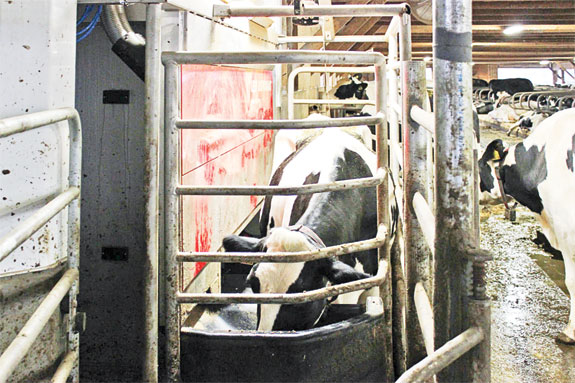
The veterinarian visits every second week to do postpartum checks and monitor the overall health status with the goal of preventing little problems from growing into real trouble. Hoof trimming is done on a monthly basis, mostly by Curtis, with a professional called in if needed.
Family
All four family members take on responsibilities for the operation. Curtis is the main operator. Allan is available to help with decisions and helps out as necessary. Dianne keeps the books; Katelyn tends to the calves.
They have scheduled monthly meetings where all are present, to work out any differences of opinion. “All going pretty good,” Allan states, adding that, “maintaining good communication is a huge issue, but our generation is very blessed ... not many challenges.”
Allan and Dianne are far from retired, though – in addition to the dairy operation, they run a 6,500-bird broiler breeder farm. Before Curtis and Katelyn came on board, Dianne handled this herself while Allan ran the dairy.
There is not much time off yet, though. Allan explains that they fill in for each other as required, but they are not working 10-hour days every day, and they do minimal work on the weekends.
All are involved in local churches. “Church is an important part of life,” Allan states. Curtis and Allan both enjoy golf, and Allan mentions camping as another activity he enjoys. Curtis and Katelyn are starting to become involved in Young Farmers, and hope to continue.
Allan describes his biggest reward as seeing the next generation taking over. “The excitement is fun to watch,” he says. There should be plenty of that in the next years.
Baby Madison, Allan and Dianne’s first grandchild, and the fourth generation of the family to live on the farm, arrived a few months ago and is sure to provide lots of that commodity. PD
Alice Guthrie is a freelance writer from Hagersville, Ontario.
PHOTOS:
FIRST: An automatic feed pusher keeps feed from straying too far out of reach for the cows.
SECOND: Just as Allan Mulder was welcomed into the family farm, he and his wife, Dianne, have done the same for their oldest daughter, Katelyn, and son-in-law, Curtis Delange. Pictured, left to right, are Curtis, Katelyn, baby Madison, Dianne and Allan.
THIRD: Even though Allan Mulder, left, has passed the day-to-day operations of the farm to his son-in-law Curtis Delange, right, they still meet often to discuss certain decisions.
FOURTH: Cows are milked throughout the day by two new robotic milkers installed at the dairy. Photos courtesy of Gifford Acres Farm, Ltd.
